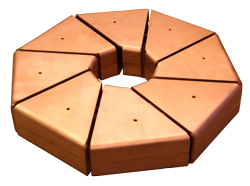

They are useful in all kinds of electronic switching devices – especially power supplies from 1 Watt to 1000 Watts maximum, since more powerful applications are usually out of range of ferritic single core and require grain oriented lamination cores. The ferrite cores used for power transformers work in the low frequency range (1 to 200 kHz usually ) and are fairly large in size, can be toroidal, shell, or shaped like the letters ‘C’, ‘D’, or ‘E’. Cores can also be classified by shape, such as toroidal cores, shell cores or cylindrical cores. There are two broad applications for ferrite cores which differ in size and frequency of operation: signal transformers, which are of small size and higher frequencies, and power transformers, which are of large size and lower frequencies. It is important to select the right material for the application, as the correct ferrite for a 100 kHz switching supply (high inductance, low loss, low frequency) is quite different from that for an RF transformer or ferrite rod antenna, (high frequency, low loss, but lower inductance), and different again from a suppression ferrite (high loss, broadband) Īs any given blend has a trade off of maximum usable frequency, versus a higher mu value, within each of these sub-groups manufacturers produce a wide range materials for different applications blended to give either a high initial (low frequency) inductance, or lower inductance and higher maximum frequency, or for interference suppression ferrites, a very wide frequency range, but often with a very high loss factor (low Q). The exception is with common mode inductors, where the threshold of choice is at 70 MHz. NiZn ferrites exhibit higher resistivity than MnZn, and are therefore more suitable for frequencies above 1 MHz.įor applications below 5 MHz, MnZn ferrites are used above that, NiZn is the usual choice.

Nickel-zinc ferrite ( NiZn, with the formula Ni aZn (1−a)Fe 2O 4).MnZn have higher permeability and saturation levels than NiZn. Manganese-zinc ferrite ( MnZn, with the formula Mn aZn (1−a)Fe 2O 4).The low coercivity means the material's magnetization can easily reverse direction while dissipating very little energy ( hysteresis losses), at the same time the material's high resistivity prevents eddy currents in the core, another source of energy loss. They have a low coercivity and are called " soft ferrites" to distinguish them from " hard ferrites", which have a high coercivity and are used to make ferrite magnets. Ferrites that are used in transformer or electromagnetic cores contain iron oxides combined with nickel, zinc, and/or manganese compounds. Ferrites are ceramic compounds of the transition metals with oxygen, which are ferrimagnetic but nonconductive.


 0 kommentar(er)
0 kommentar(er)
